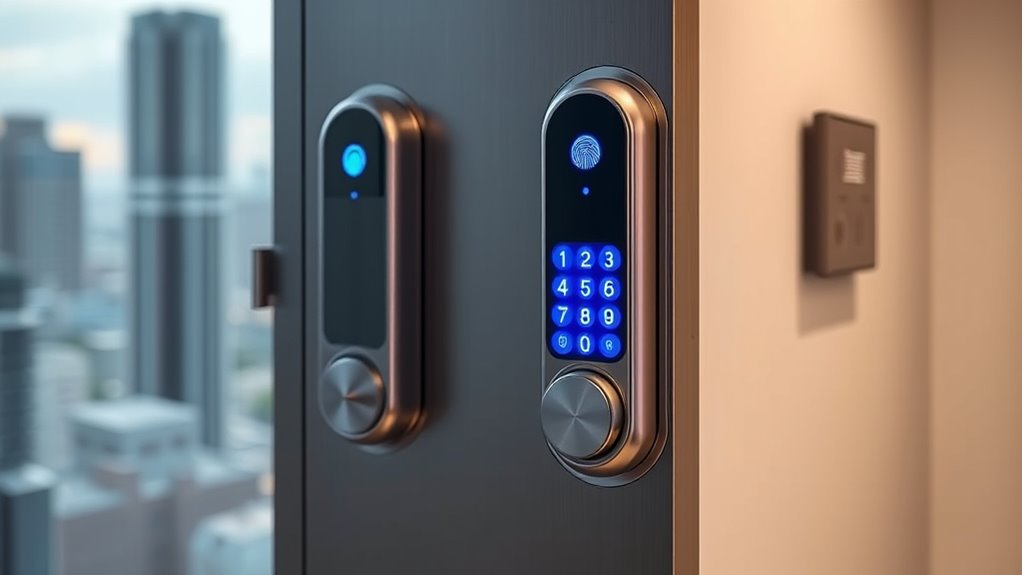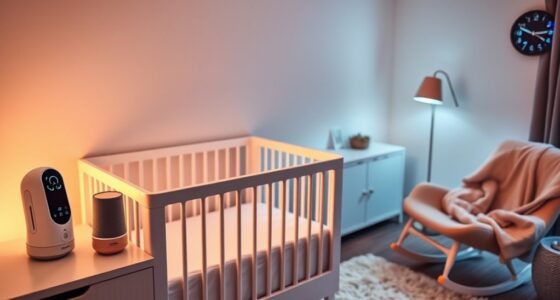Smart locks can be a secure choice for apartments if they use strong encryption like AES-256, multi-factor authentication, tamper sensors, and activity logs. Regular firmware updates and unique passwords further protect against hacking. Choosing models with security certifications and backup access options boosts safety. Proper setup and maintenance are essential to prevent vulnerabilities. Want to know how to maximize your smart lock’s security? Keep exploring for expert tips and best practices.
Key Takeaways
- Modern smart locks use strong encryption like AES-256 to prevent hacking and unauthorized access.
- Multi-factor authentication and activity logs enhance security by tracking entries and preventing breaches.
- Regular firmware updates fix vulnerabilities, ensuring ongoing protection against cyber threats.
- Backup options like physical keys and battery packs prevent lockouts during power or connectivity failures.
- Combining smart lock features with best security practices creates a layered, reliable security solution for apartments.
How Do Smart Locks Protect Your Apartment?
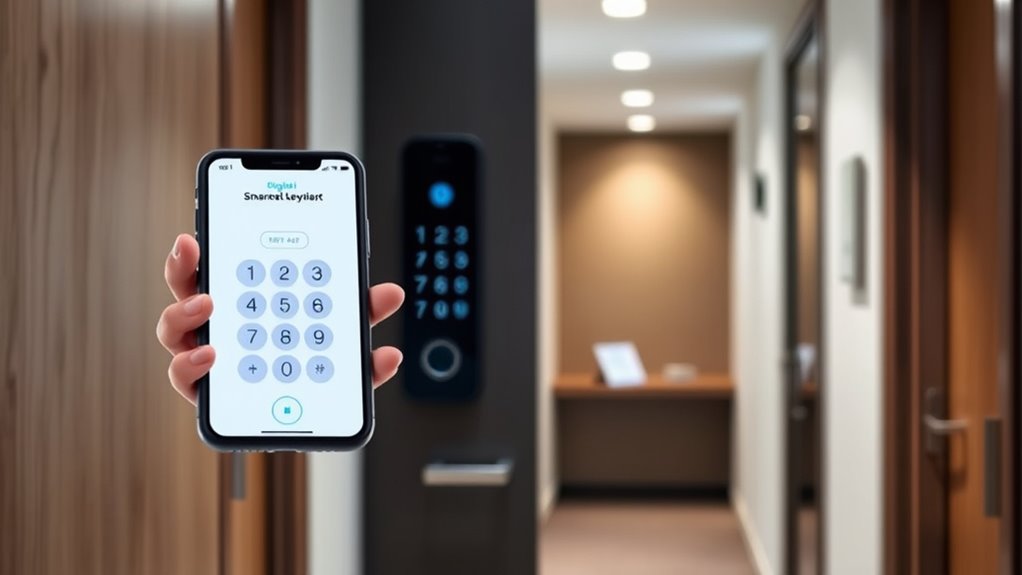
Smart locks protect your apartment by using advanced encryption, like AES-256, to secure digital credentials and prevent unauthorized access. This encryption guarantees that your entry codes and keys stay private, making hacking difficult. They also keep access logs, so you can see who entered and when, adding an extra layer of security. Many models include tamper sensors and alarms that alert you or security personnel if someone tries to force entry or tamper with the lock. Remote control features let you instantly revoke or grant access, reducing the risk of lost keys or unauthorized copies. Additionally, multi-factor authentication—like biometrics or temporary digital codes—further strengthens your apartment’s security by requiring multiple verification methods for entry. Secure connection protocols help ensure that data transmitted between your device and the lock remains protected from interception or hacking. Moreover, some smart locks incorporate security features such as anti-tamper mechanisms to deter physical attacks. Incorporating cybersecurity measures is crucial to protect these devices from potential digital threats. Implementing regular firmware updates also helps patch vulnerabilities and enhances overall security.
Encryption and Authentication Methods Used by Smart Locks
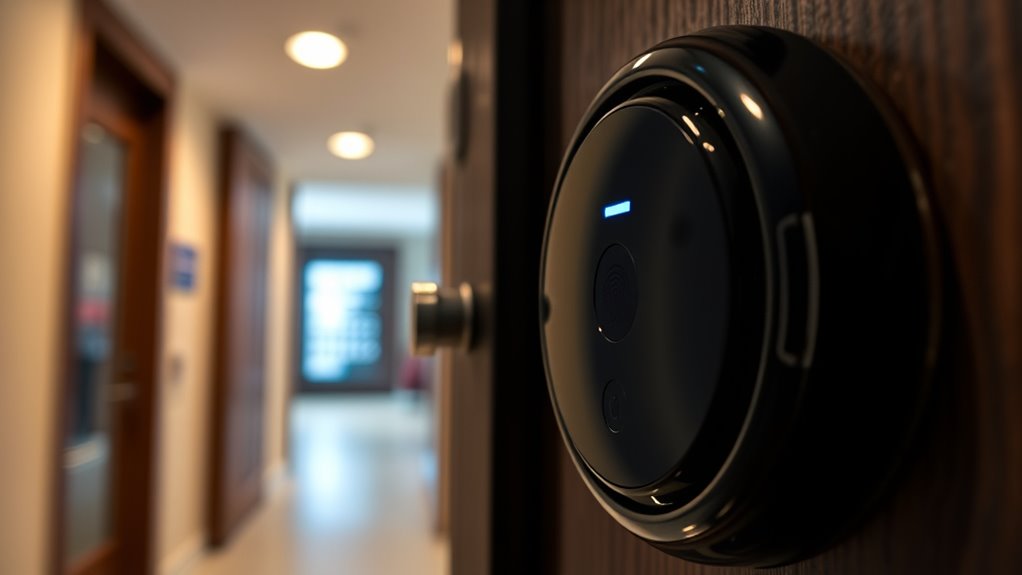
Encryption and authentication methods are crucial for guaranteeing the security of digital access points, especially in smart locks. Many utilize advanced encryption like AES-256 to protect data transmission from hackers. Multi-factor authentication, including biometric verification or unique codes, adds extra security. Communication technologies such as Bluetooth, Wi-Fi, Z-Wave, and Zigbee employ secure pairing and robust security protocols to prevent unauthorized access. Regular firmware updates and patches are necessary to fix vulnerabilities and maintain encryption integrity. Some smart locks also feature tamper alerts and intrusion detection to notify you if encryption or authentication is compromised.
| Security Feature | Functionality |
|---|---|
| Secure Pairing | Ensures safe device connections |
| Firmware Updates | Maintain encryption strength and fix vulnerabilities |
| Multi-factor Authentication | Adds layers of security beyond passwords |
| Tamper Alerts | Notify if encryption or authentication is tampered |
Common Security Features of Modern Smart Locks
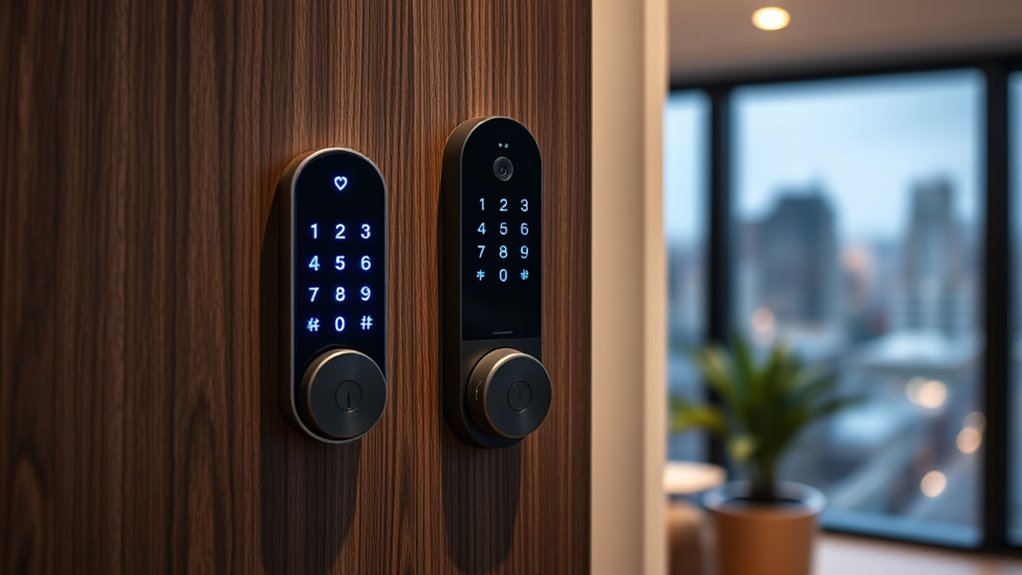
Modern smart locks incorporate a range of security features designed to protect your home from unauthorized access. Advanced encryption, like AES-256 and TLS, guarantees that communication between your devices remains secure and resistant to hacking. Encryption protocols ensure that data transmitted between devices is safeguarded against interception and tampering.
Tamper sensors and alarms detect any unauthorized attempts to interfere with the lock, alerting you immediately. These sensors can also alert your smartphone or security system if tampering is suspected.
Auto-locking mechanisms add an extra layer of security by automatically securing your door when needed. This feature helps prevent accidental lockouts and ensures your home remains protected even if you forget to lock the door manually.
Multi-factor authentication, such as biometrics, passcodes, or temporary digital keys, verifies identities more effectively. This approach makes unauthorized access significantly more difficult compared to traditional locks.
Additionally, activity logs record every entry and exit, giving you a detailed security trail. Maintaining a record of access can be useful for both security and monitoring purposes.
Seamless integration with existing security systems and smart home platforms allows you to manage and monitor your lock easily, enhancing overall security and peace of mind. Compatibility with various systems ensures that smart locks can be incorporated into your broader home automation setup, providing centralized control.
Potential Vulnerabilities and How to Prevent Them
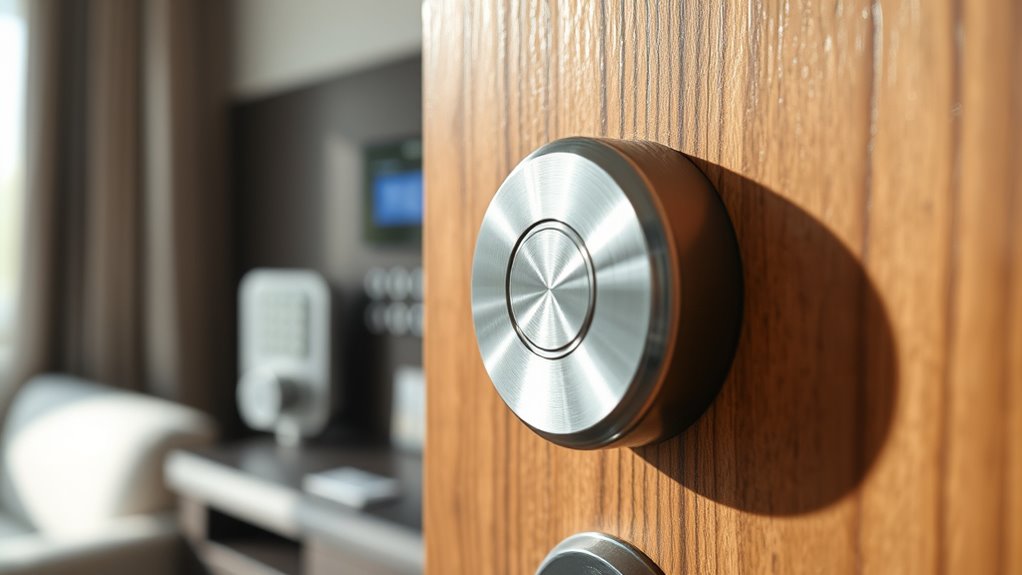
Smart locks can be vulnerable to hacking if they don’t use strong encryption, so it’s essential to choose models with advanced security protocols. Power outages or system failures can lock you out, making backup access methods like physical keys indispensable. Regular firmware updates are important, as unpatched vulnerabilities increase the risk of unauthorized access through signal interception or tampering. Additionally, understanding sound recording techniques can help in evaluating the security features of smart locks that incorporate audio verification or alerts. Being aware of encryption standards can further enhance your ability to select a secure device that protects against eavesdropping and hacking attempts. Moreover, staying informed about security certifications can provide extra assurance of a lock’s resilience against cyber threats. Regularly reviewing the update process of your smart lock ensures that it remains protected against emerging vulnerabilities. Recognizing the importance of encryption protocols can also guide you toward choosing devices that prioritize user data protection and integrity.
Hacking and Cybersecurity Risks
While smart locks offer convenience, they also face cybersecurity threats that can compromise your security. Cybercriminals may exploit vulnerabilities in your device through hacking, especially if weak passwords or unencrypted communication protocols are in place.
Firmware flaws or outdated software can be targeted, giving hackers access to your lock system. Relying on cloud-based services introduces additional risks, as these can be attacked, leading to data breaches or unauthorized control. Incorporating AI security technologies can help detect and prevent such threats more effectively. Regular security audits and vulnerability assessments are essential to identify potential weaknesses before they can be exploited. Additionally, understanding cybersecurity risks associated with IoT devices can help you make more informed security decisions. Staying informed about emerging cyber threats enables proactive defense strategies.
To protect yourself, consider the following:
- Use strong, unique passwords and enable multi-factor authentication.
- Keep firmware and software up to date with regular updates.
- Ensure the lock employs end-to-end encryption for secure communication.
- Regularly monitor your device for suspicious activity and unauthorized access attempts.
Taking these precautions helps safeguard your smart lock against hacking and cybersecurity threats.
Power Outages and Failures
Power outages and power failures can disrupt the functionality of your smart lock, potentially locking you out if you haven’t prepared for such events. Since smart locks rely on batteries, a depleted battery or power loss can prevent access, especially if backup power isn’t available. Many models include low-battery alerts or a manual override with mechanical keys to keep you secure during outages. Connectivity issues may also occur if Wi-Fi or Z-Wave networks lose power, affecting remote access. To prevent lockouts, regularly check and maintain your battery life, and consider locks with external battery packs or wired power options. Automation technologies can help monitor and alert you about battery status, ensuring you’re prepared before a failure occurs. Having a backup plan guarantees you won’t get locked out when the power goes out, maintaining both convenience and security. Staying aware of potential angel number patterns can also serve as a reminder to prepare for unexpected disruptions and stay vigilant about your security. Regular maintenance and understanding your lock’s circuitry are essential to prevent unforeseen failures and ensure reliable operation during emergencies. Additionally, understanding the nutritional value of juices can serve as a helpful analogy for keeping your smart lock’s power source well-maintained and topped up. Moreover, being informed about how AI develops cures for common issues can inspire proactive measures to safeguard your smart home systems against failures.
The Importance of Regular Firmware Updates

Regular firmware updates are essential to keep your smart lock secure and functioning properly. They fix security flaws, improve compatibility with other devices, and prevent system malfunctions. Staying current with updates helps protect your home from cyber threats and guarantees your lock performs reliably. Additionally, understanding city dynamics can help you better manage your smart home devices within a connected urban environment. Ensuring your device’s software includes security patches is crucial for defending against potential vulnerabilities.
Patch Security Vulnerabilities
Keeping your smart lock secure requires regularly updating its firmware, as these updates fix known vulnerabilities that hackers might exploit. Firmware updates address security vulnerabilities, improve encryption protocols, and deliver essential security patches. Without these updates, your device remains exposed to cyber-attacks like hacking, unauthorized access, or data breaches.
To stay protected, consider automating firmware updates or enabling notifications for new releases, ensuring timely installation of security patches. Staying informed about firmware release notes helps you understand recent security improvements.
Remember, neglecting updates can leave your smart lock vulnerable and compromise your apartment’s safety.
- Regular firmware updates close security vulnerabilities before hackers can exploit them
- Improved encryption protocols strengthen data protection during cyber-attacks
- Security patches fix bugs and reduce the risk of unauthorized access
Enhance Device Compatibility
To guarantee your smart lock remains compatible with the latest smart home devices and ecosystems, updating its firmware regularly is essential. Firmware updates provide security patches that address system vulnerabilities, reducing the risk of cyberattacks.
Manufacturers often release updates to fix bugs, enhance encryption protocols, and improve device stability. Staying current with firmware ensures your lock can work seamlessly with new features and compatibility options, adapting to evolving smart home systems.
Neglecting updates may leave your smart lock susceptible to exploits, compromising security and privacy. Regularly installing firmware updates not only strengthens protection against threats but also ensures your device remains integrated with your smart home ecosystem, delivering reliable performance and peace of mind.
Prevent System Malfunctions
Updating your smart lock’s firmware regularly is essential for preventing system malfunctions that could compromise your access control. Firmware updates deliver critical security patches that fix vulnerabilities, reducing the risk of hacking attempts. They also improve system stability, which helps prevent malfunctions that might lock you out or cause delays.
Manufacturers often release updates to enhance encryption protocols, guarding against cyber threats. Ignoring these updates can leave your smart lock exposed to known exploits, increasing security risks in apartment settings.
To keep your lock running smoothly and securely, schedule periodic checks for firmware updates. Staying up-to-date ensures your device functions reliably and maintains ideal protection against emerging vulnerabilities.
- Regular firmware updates keep your system stable and secure
- Installing security patches prevents vulnerabilities that hackers target
- Updating enhances encryption, reducing cyber threats
Multi-Factor Authentication and Access Control Options
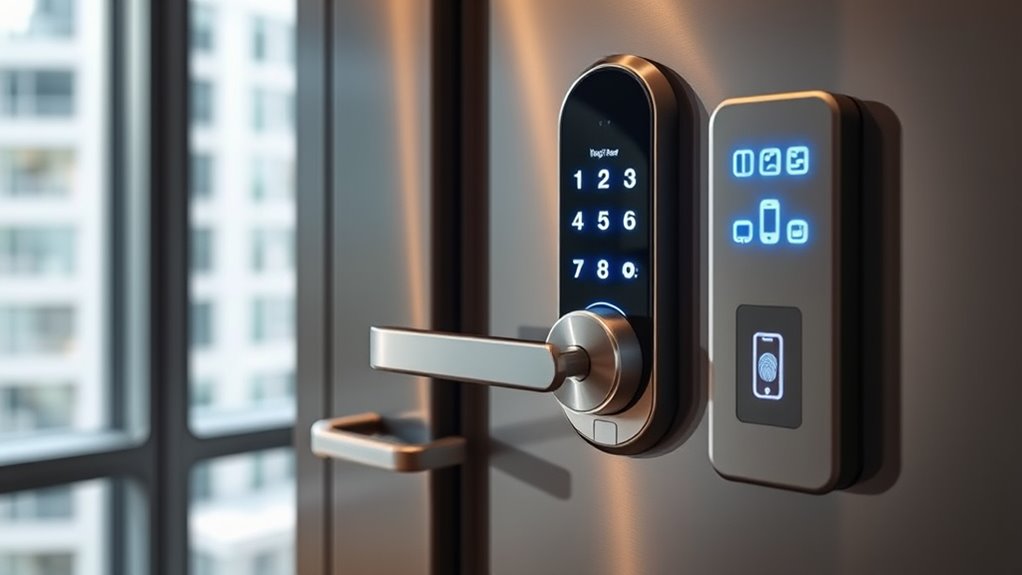
Many smart locks now support multi-factor authentication, combining methods like PIN codes, biometric scans, and smartphone apps to boost security. This multi-factor access control minimizes the risk of unauthorized entry, even if one method is compromised.
Biometric security, such as fingerprint or facial recognition, adds an extra layer of protection alongside digital keys or passcodes. To safeguard your data, these locks use encryption protocols like TLS and end-to-end encryption, ensuring your authentication information remains secure from hacking attempts.
Implementing multi-factor authentication helps verify that only authorized residents or personnel can access your apartment, increasing overall security. Virtual keys can also be used, allowing secure, remote access without sacrificing the integrity of your access control system.
How Activity Logs Enhance Security Monitoring
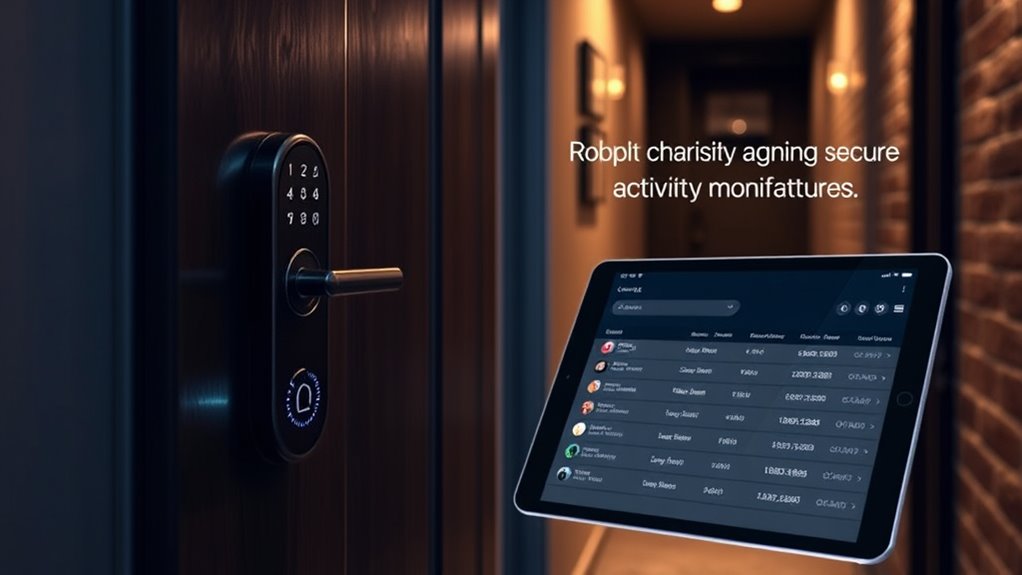
Activity logs in smart locks play a crucial role in security monitoring by tracking every entry and exit with precise timestamps. These digital logs create a detailed record that helps you understand who accessed your apartment and when.
With real-time activity, property managers can quickly detect suspicious or unauthorized access attempts, enhancing security. Reviewing logs remotely through apps or management systems means you don’t need to be physically present to stay informed.
This constant oversight allows for prompt responses to potential security threats. Plus, accurate activity logs support investigations by providing verifiable data about access events.
They also enable instant alerts for unusual activity, helping you stay a step ahead of security breaches. Overall, activity logs are essential for maintaining a proactive and reliable security monitoring system.
Choosing a Secure Smart Lock for Your Apartment
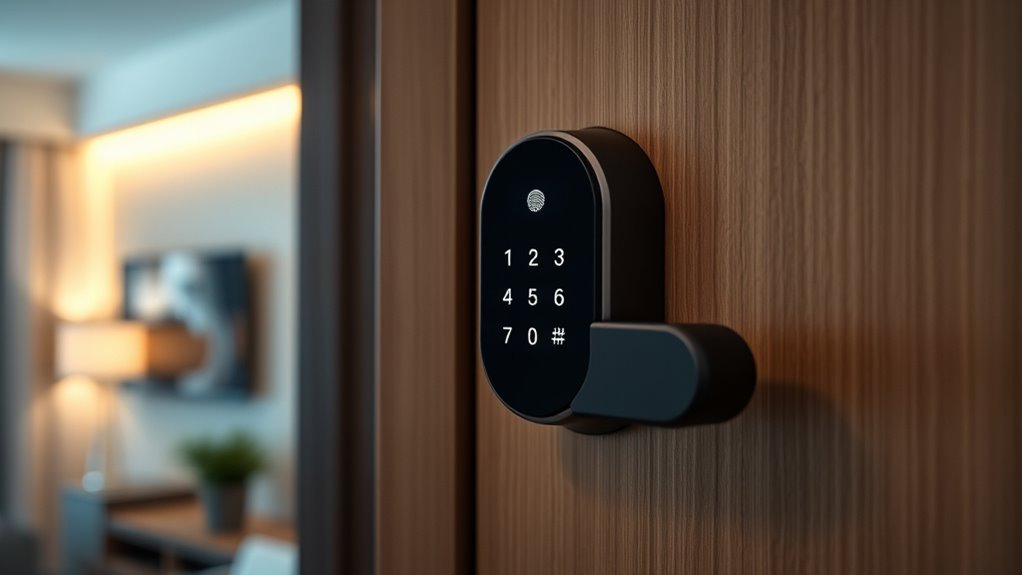
Choosing a secure smart lock for your apartment requires careful consideration of its security features and compatibility with your existing systems. Look for models that use advanced encryption, like AES-256, to protect against hacking. Multi-factor authentication, such as biometrics combined with digital codes, adds extra security. Tamper alerts can notify you of any intrusion attempts, while regular firmware updates keep vulnerabilities at bay. Proper installation and integration with your security system are essential to maximize protection. When selecting a lock, compare features:
| Feature | Benefit |
|---|---|
| Encryption | Prevents hacking attempts |
| Multi-factor auth | Ensures only authorized users access |
| Tamper alerts | Detects and notifies of tampering |
This approach helps you choose a smart lock that’s both secure and reliable.
Best Practices for Maintaining Smart Lock Security
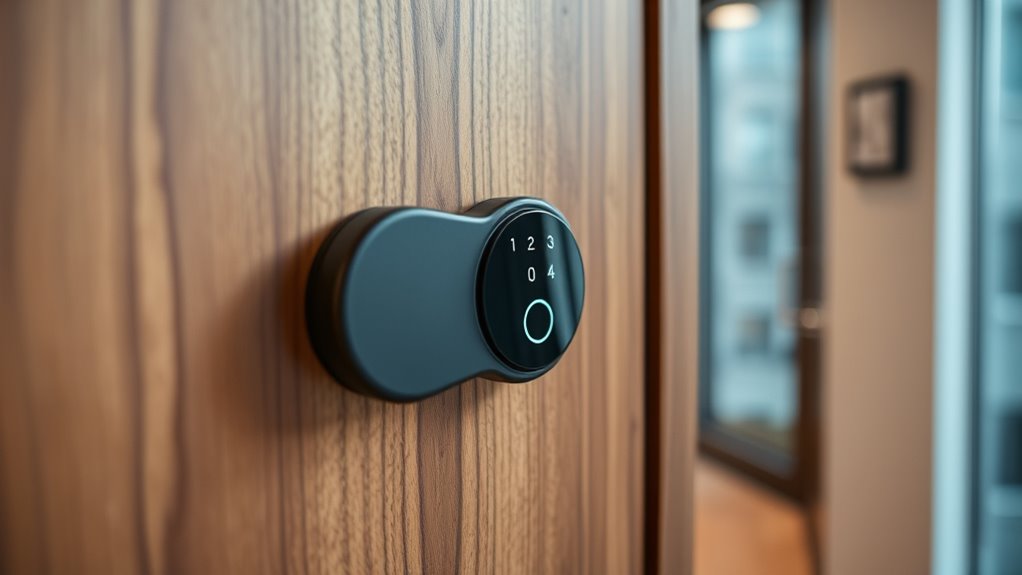
Maintaining your smart lock’s security is an ongoing process that requires consistent effort. Regularly update your smart lock’s firmware and app to stay protected against the latest vulnerabilities. Enable multi-factor authentication whenever possible to add an extra layer of security beyond just passwords or PINs.
Monitor activity logs frequently to catch any suspicious or unauthorized access in real-time. When you’re away for extended periods, disable remote access features to minimize attack surfaces.
To keep your smart lock secure:
- Stay current with firmware updates and app patches
- Use strong, unique passwords and multi-factor authentication
- Watch activity logs for unusual activity and disable remote access when unnecessary
Following these practices helps safeguard your apartment and keeps your data privacy intact.
Frequently Asked Questions
Can I Put a Smart Lock on My Apartment?
Yes, you can usually put a smart lock on your apartment door if it fits your existing hardware and door type. Just make sure to check your lease or ask your landlord for permission first.
Many smart locks are easy to install over standard deadbolts and offer features like remote access and activity logs.
Keep in mind, local rules and property policies might affect your ability to install one.
Are Any Smart Locks Actually Secure?
While the question of smart lock security is nuanced, many models do offer robust protection. You can find locks that utilize strong encryption like AES-256 and include features such as tamper alarms and multi-factor authentication.
However, their security heavily relies on proper installation, regular updates, and choosing reputable brands. Though no system is infallible, when maintained correctly, many smart locks provide a reliable and sophisticated safeguard for your space.
What Are the Disadvantages of a Smart Lock?
You should know that smart locks have some disadvantages. They can be vulnerable to hacking if they lack proper encryption or have outdated software.
Power outages or system failures might temporarily lock you out. Since they rely on Wi-Fi or Bluetooth, signals could be intercepted or compromised.
Physical tampering is possible if the lock isn’t well-built. Plus, sharing access codes insecurely or hacking your app account can also pose security risks.
What Are the Security Issues With Smart Door Locks?
Did you know that over 30% of smart lock users worry about hacking? The security issues with smart door locks include vulnerabilities like weak encryption, relay attacks, and signal interception.
Power outages or system failures can temporarily disable them, and weak passwords or compromised accounts increase risks.
Physical tampering and firmware hacking also threaten security, so you should weigh these risks before relying solely on smart locks for your apartment’s safety.
Conclusion
Smart locks can be a secure choice for your apartment when you stay vigilant. Did you know that over 60% of smart lock vulnerabilities stem from outdated firmware or weak access controls? Regular updates, strong authentication, and good security habits considerably reduce risks. By staying informed and proactive, you can enjoy the convenience of smart locks while keeping your home safe. Remember, technology is only as secure as the precautions you take.
